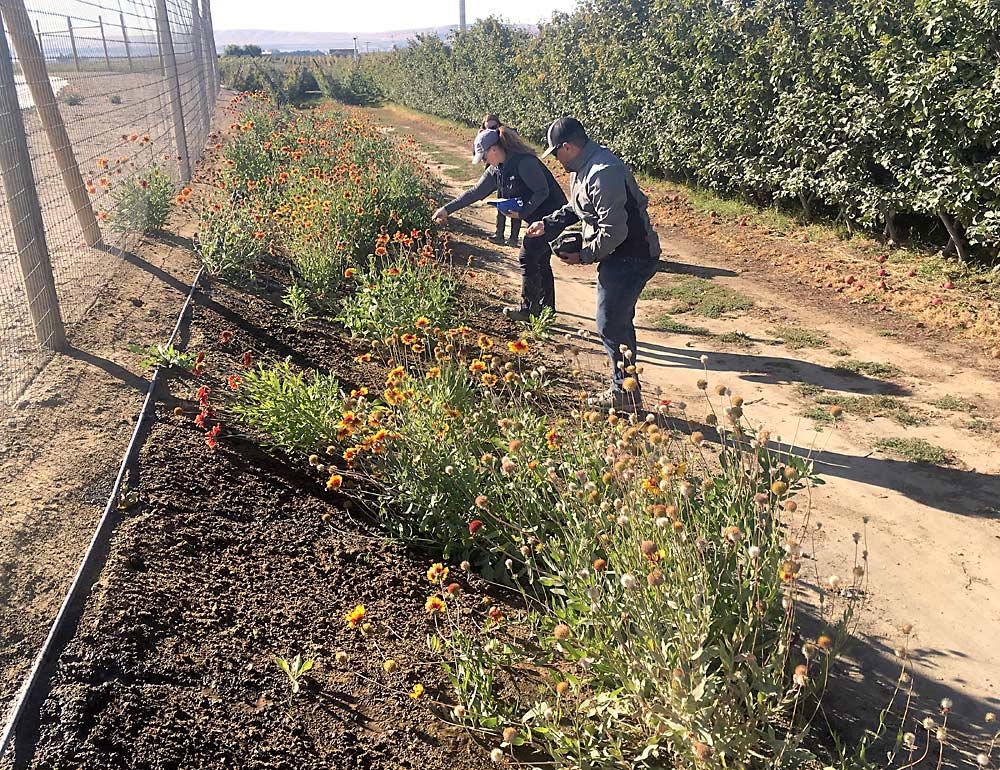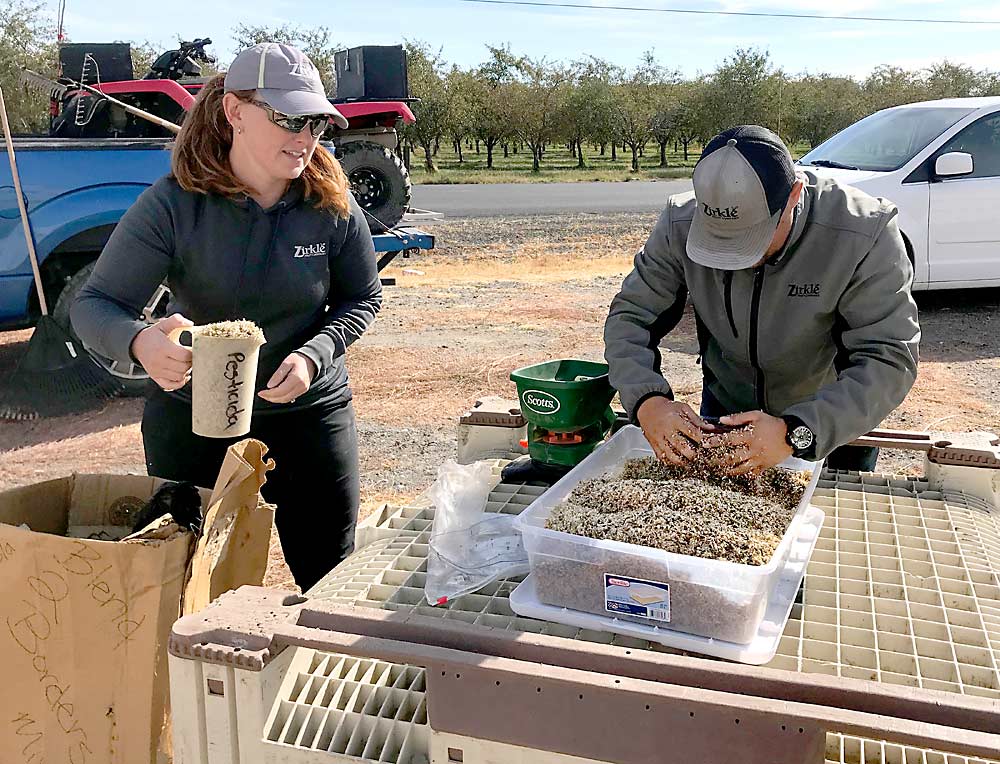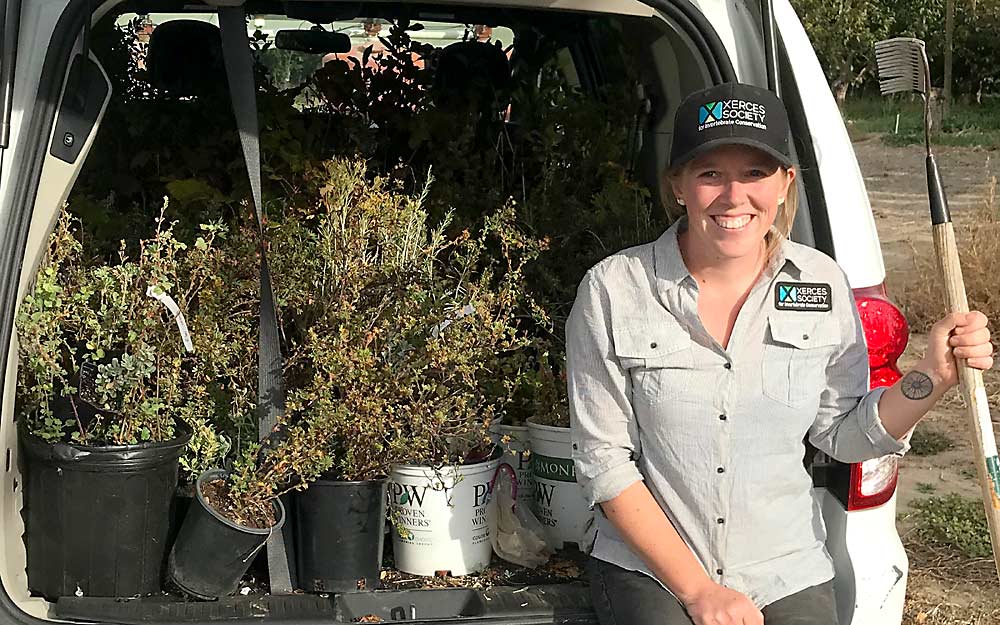
In 2017, the grower-owned cooperative Tree Top Inc. invited its growers to a meeting to learn more about grants available to help improve pollinator habitat.
The turnout wasn’t great, but two Washington growers signed on to join the program.
The result in just the first year: dozens of native, flowering plants, as well as hedgerows to protect pollinator habitat, in and around several orchards — all paid for in a partnership with General Mills Inc. and the Xerces Society for Invertebrate Conservation.
The program aims to increase the acreage of pollinator habitat in agricultural areas across the U.S. by providing free seeds and plants, as well as technical support, to growers seeking to implement conservation projects on the farm.
Originally started in 2011, the program already was working with fruit, grain and vegetable farms across the country, from tomato growers in California’s Central Valley to Midwest grain growers bordering Canada.
It’s open to any grower who produces for General Mills, and in 2017, the company and Xerces Society reached out to Tree Top, producer of juice and other fruit products, in hopes of expanding the program to tree fruit.
“The goal is really to put native habitat back into the landscape and to support pollinators and other beneficial insects on the landscape,” said Cameron Newell, pollinator conservation specialist for Xerces Society. But, he noted, “it also supports honeybee health in these orchards.”
Harold Austin, director of orchard administration for Selah, Washington-based Zirkle Fruit Co., said that some of their ranch managers had already been working to deploy similar efforts in the company’s organic blocks for eight or nine years. But when he heard there was money on the table to do more, he jumped at the opportunity.
“Over the years, the sheer volume of pollinators — whether it’s moths, butterflies, different types of small bees that are working and a number of bumblebees — we’ve seen those numbers increase dramatically wherever we’ve gone out,” Austin said. “This part of the approach that we use for organics, we’re seeing it’s beginning to work, so we’re starting to expand to our conventional blocks as well.”
With the aid of a Xerces Society adviser, who brought in all the plants and seeds, Zirkle Fruit planted 1,775 feet of hedgerow between the edge of an orchard under conversion to organics and a maintenance road for the Kittitas Irrigation District.

The hedgerow will serve dual purposes, drawing different types of birds to the area but also different beneficial insects from the natural plants in the surrounding area. It features a range of about 20 different alternating shrubs and subshrubs on 6-foot centers, from serviceberry and chokecherry to sagebrush and Canada goldenrod.
Inside the orchard, from the north end of the farm to the south, a swath of seeds for some 15 different natural plants — think yarrow, woollypod milkvetch, Piper’s buckwheat and longleaf phlox — was planted along 2,250 feet to draw those predators and beneficial insects to the interior of the farm. They include wasps that feed on aphids and predator insects that feed on red mites.
“We’ve seen some of these things starting to occur. The sheer amount of biodiversity that’s taking place in these plantings, it’s a whole life of its own,” Austin said.
Not just a grant
Involvement by the Xerces Society isn’t limited to just free seeds and plants.
The organization provides detailed plans for each planting, listing bloom times for all of the proposed plants to ensure habitat for pollinators and beneficial insects over the course of the season, as well as a detailed timeline for site preparation, planting and care.
The group sent an adviser to Zirkle to assist and provide technical support for the plantings last year.
At the company’s orchards near Othello, Washington, they planted some 9.5 acres of seeds for native plants and grasses that serve at least one of three roles: pollinator habitat, butterfly habitat or conservation biocontrol for beneficial species. Among those planted: blue flax, blanketflower, arrowleaf balsamroot, and bluebunch wheatgrass.
Zirkle entomologist and agricultural consultant Teah Smith aims to expand the conservation effort at several more of the company’s orchards this year, not just to improve habitat and orchard health but, ultimately, the bottom line.
A study in Michigan showed similar plantings resulted in increased yield, adding $586 per acre in revenue to the grower, she said.
“The other thing about these plantings is that native pollinators can withstand much more than honeybees — rain, colder temps, higher temps,” she said. In addition, “honeybees will actually go more toward the highest blooming trees, while native bees will visit the block more evenly.”
Smith hopes to track yields in blocks where the pollinator habitat has been planted, while also keeping tabs on pollinators and beneficial insects.

“Where I really want to see us commit is where we are transitioning blocks,” she said. “If that block is going organic, we have that boost to bring in pollinators and beneficials.”
Already, Smith releases beneficial insects to fight certain pests; in an organic Fuji block, for instance, where aphids can wreak havoc, she generally releases ladybird beetle and follows up a week later with lacewing larvae.
She then switches back and forth over, say, a six-week period, ultimately releasing some 5,000 ladybird beetles per acre and 2,000 lacewing larvae per acre.
Improving habitat for those beneficials ensures they stick around, too, she said.
“This is just another tool in our toolbox, especially for organic growers trying to conserve their beneficials and provide more nectar for them,” she said.
General Mills, headquartered in Golden Valley, Minnesota, has contributed $6 million to habitat restoration nationally since 2011. The goal of this five-year, $4 million project is to plant over 100,000 acres of pollinator habitat.
The Zirkle projects were funded specifically through the grant program established by General Mills and offered to growers of the Tree Top cooperative.
Xerces Society hopes to entice more Tree Top growers to participate; however, at the same time, the organization has additional funding through the Natural Resources Conservation Service for other projects that growers might be eligible for, Newell said.
For more information, visit xerces.org. •
—by Shannon Dininny






Leave A Comment